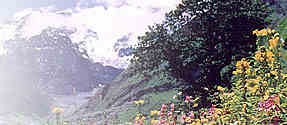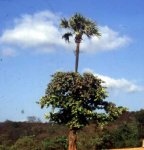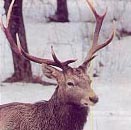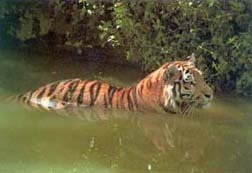Adventure
 'I believe any trip in search of wildlife can be coupled with physical activity and elements of cultural diversity to form a thrilling opportunity ' 'I believe any trip in search of wildlife can be coupled with physical activity and elements of cultural diversity to form a thrilling opportunity '
John H.Eickert
Of the places I have traveled, India is my favorite country. There is such an amazing diversity of landscape, people, culture, and climate. Indeed, there is somewhere interesting to visit, every month of the
year. My favorite place in this favorite country is Ladakh. Here is a high elevation area as dry as the Sahara, yet containing the largest glaciers outside of the world’s polar regions. Ladakh is a land where arid plains ascend to the world’s highest plateau
in a jumble of glacial clad mountains and deep river canyons. A land in crossroad of a continent and meeting place of the world’s three largest religions, Islam, Hindu, and Buddhist. Ladakh is a land of mountain majesty and inner spirituality.
 The trek from Lamayuru to Hemis begins at the oldest monastery and ends at the most famous monastery. The first part crosses three easy passes before descending to Chiling. At Chiling, you can swim the Zanskar or use the cable car. I recommend the cable
car. From the Zanskar it is a gradual ascent up the Markha Valley. There are Mani walls and smiling faces all along the way. The scenery is spectacular. The mountains Stok Kangri and Kan Yatse seemingly guard the high pastures while shepherds tend to their
yaks and goats. From Markha to Hemis the track grinds up Kongmaru La, the highest point of the trip. Phew! Near Hemis is Hemis National Park, created to protect a small portion of this rare area and hopefully shelter the few remaining snow leopards. The Park
is home to the ibex and bharal sheep. There is also an interest species of quail. Of all the wildlife here, in my two days at Hemis, I only saw the quail. Oh, well. The trek from Lamayuru to Hemis is relatively easy, there is not an overly amount of up and
down. However, keep in mind this trek will take ten to twelve days with and average five to six hours of walking each day. That is a lot of walking! The best time of year is June through September. It can get very cold any time of the year. Be prepared. Near
here is the village of Dras, which is reported to be the coldest village in India. The beaches of Goa are a long way to the south! The trek from Lamayuru to Hemis begins at the oldest monastery and ends at the most famous monastery. The first part crosses three easy passes before descending to Chiling. At Chiling, you can swim the Zanskar or use the cable car. I recommend the cable
car. From the Zanskar it is a gradual ascent up the Markha Valley. There are Mani walls and smiling faces all along the way. The scenery is spectacular. The mountains Stok Kangri and Kan Yatse seemingly guard the high pastures while shepherds tend to their
yaks and goats. From Markha to Hemis the track grinds up Kongmaru La, the highest point of the trip. Phew! Near Hemis is Hemis National Park, created to protect a small portion of this rare area and hopefully shelter the few remaining snow leopards. The Park
is home to the ibex and bharal sheep. There is also an interest species of quail. Of all the wildlife here, in my two days at Hemis, I only saw the quail. Oh, well. The trek from Lamayuru to Hemis is relatively easy, there is not an overly amount of up and
down. However, keep in mind this trek will take ten to twelve days with and average five to six hours of walking each day. That is a lot of walking! The best time of year is June through September. It can get very cold any time of the year. Be prepared. Near
here is the village of Dras, which is reported to be the coldest village in India. The beaches of Goa are a long way to the south!
Lamayuru is reached by rough road from Leh. Depending on conditions, this may take the better portion of a day. Of course, time should be spent at the monastery in Lamayuru, so trekking would begin on your second day. Leh is reached from Delhi by plane and
road. I strongly recommend hiring a car in Delhi for the drive to Leh. Buses do not stop as often and in the places, you might wish. Planes reach Leh too quickly for proper acclimatization. In flying you will also miss some amazing scenery, as well as a number
of Islamic and Hindu religious sites. As I say, take the time and take your time. Enjoy!
Visit
http://www.numbum.net or call NumBum Adventurers at 406-777-2228
|
Amazing Facts About Wildlife
By Prashant Mahajan, senior Education Officer, BNHS, Mumbai
Scientific name: Ficus benghalensis
 Banayan is one of the common trees planted as a shade tree along the city roads Banayan is one of the common trees planted as a shade tree along the city roads
and highways. However, a palm tree growing out of Banyan tree makes an
interesting observation. As a matter of fact the palm does not grow from the
Banyan but its Banyan which grows around the palm tree.
 This is a fascinating creation of birds. Many birds cherish the globular, This is a fascinating creation of birds. Many birds cherish the globular,
stalk-less figs of Banyan. One of such birds defecates on the palm tree. During
rainy season, the undigested seeds germinate and send thread-like small roots to
the ground. These roots then surround the palm tree with a delicate network.
These roots further thicken and become like mighty ropes. The powerful roots
then start pressing and squeezing the stem of the palm so strongly that all the
capillaries that carry water from ground to the top of the palm get crushed and
blocked. Eventually the palm dies off and its trunk decomposes and disappears
leaving behind a strange, hollow, cage-like structure, formed by the strangler
roots of the Banyan tree hence called "Strangler fig. However the two can
co-exist for along time.
Banyan is found in the sub-Himalayan forests and peninsular India. It has smooth
bark and large leathery leaves. The leaves are used as fodder for captive
elephants and camels. The leaves are also made in to plates. The fruits are fig
like which appear between April and June and October and November as well.
The Banyan is sacred to the Hindus and Buddhists. The great Banyan of Calcutta
has around 1000 trunks. The canopy covers 4 acres and a walk around the tree is
about 400 meter. One can see huge Banyan tree under total control of a palm tree
in gardens, roadside, forest area or agricultural land.
|
Answers To Quiz Of The Month
Last month no one has given all right answers
Right Answer to
Quiz on elephant poaching
|
| 1.The word `elephant` is derived from the Greek word `elephas` which means …... |
|
| 2.The lustrous white dentin called ivory are actually--------------------- of elephants. |
|
upper molars |
upper incisors |
horns
|
|
| 3.The Asian elephnt is today found only in…… |
|
6 countries |
13 countries |
23 countries
|
|
| 4.The price of ivory shot up to $ 285 per kg in 1996. The poachers however got …
|
|
$ 30 per kg |
100 per kg |
$ 150 per kg
|
|
| 5.The poaching of 6 elephants in Corbett National Park in 2001, was traced to …. |
|
poachers` gun shots
|
poisoning by Lisu tribe of Arunachal Pradesh |
poaching by electrocution
|
|
| 6.Poaching is a big problem in S. India which has more than 50% of India`s elephant population. The adult male to female ratio in a healthy populatin is 1:2. In S. India, the ratio is ………………. |
|
| 7.Upto 80% of the ivory that reaches Japan is used for
|
|
re exporting |
making hankos ( signature seals) |
carving artifacts
|
|
| 8.After Japan, the second largest destination for illegal ivory is
|
|
Hongkong |
Bangkok |
Mainland China
|
|
| 9.The town of ……. on the Kerala coast is perhaps the single most exit point for ivory from the South.
|
|
| 10.Nepal, Bhutan, Bangladesh, China & Vietnam have elephant poulations of less than
|
|
Please try our quiz for the current month on
tiger poaching
|
Endangered
(Cervus elaphus hanglu)
 The Hangul Deer is an endangered species of red deer listed in the IUCN Red List of threatened animals. It inhabits the thick forests of Jammu & Kashmir. In the past, Jammu & Kashmir had a large and vibrant population of Hangul
Deer. But environmental pressures caused by hunting and loss of habitat from deforestation and dam projects has significantly curbed the wild population of Hangul Deer. Jammu & Kashmir does have one reserve and conservation area for Hangul Deer; the Dachigam
National Park, also home to a diversity of wildlife. The Hangul Deer is an endangered species of red deer listed in the IUCN Red List of threatened animals. It inhabits the thick forests of Jammu & Kashmir. In the past, Jammu & Kashmir had a large and vibrant population of Hangul
Deer. But environmental pressures caused by hunting and loss of habitat from deforestation and dam projects has significantly curbed the wild population of Hangul Deer. Jammu & Kashmir does have one reserve and conservation area for Hangul Deer; the Dachigam
National Park, also home to a diversity of wildlife.
'Big stags cast their horns about March 15 to April 1st. Young ones often carry their antlers into May. After shedding their horns most go up hill and congregate under the snow line, as soon as the weather get warm. The rutting
seasons commence about September 15. In hard winters when there is heavy snowfall the stags come down in March also. Where there is green pasturage, they descend.
The female has no horns. The colouring depends on the climate of the place where they live and also on the age. The hair on the neck is coarse, long and sometimes thick. This is much less marked on the female than on the male.
The hair on the lower part of the neck of the stag is very long and in an old animal very dark brown
Like other environmental problems in Jammu & Kashmir, the armed conflict of the last 8 years has also caused terrible pressures on the wild Hangul Deer population. Wildlife experts say the numbers may have dwindled to less than
170 in its only habitat, the Dachigam National Park near the capital, Srinagar.
A slew of factors is responsible for the hangul's population slide. "The presence of a sheep-breeding farm inside the park poses the danger of spreading domestic cattle diseases besides being an unnecessary intrusion into the
hangul's pastures and grazing fields."
The presence of security forces has also created havoc. A company of the Indian paramilitary, the Border Security Force (BSF), is camped inside the park. Their vehicles are a constant disturbance to deer and other wildlife.
Heavy movement of VIPs in the park is also a vexing issue. The Government of Kashmir has launched a massive awareness campaign to educate people to protect wild life. It has also been decided to set up conservation breeding centers
or deer parks at Dachigam and in the hill resorts of Pahalgam and Gulmarg.
( Photograph-courtesy BNHS magazine "Hornbill")
.
|
Members Speak
Here is a query from
Dr. Sudipta Mitra.
Let me introduce my self as a member of the Indian Wild life club and a Kolkata based wild life enthusiast and photographer, observing and photographing Indian wild life all over the country (though by profession I am doctor). It is really a pleasure to interact
with like-minded people like you, even from the far eastern part of the country.
To cut the long story short I would like to inform you that in the end of the month of February 2004 I have planned to visit Gir sanctuary for about 7 days and for that reason I really need your help.
Could you please inform me that whether tourists are allowed to visit the National Park area of the forest or, the rides are only restricted to the Sanctuary area outside the national park ? Are Maruti Gypsies allowed inside?
Expensive Taj hotel is not affordable to me for such a long period. Could you please suggest any other standard hotel at Sasan and the contact numbers of the same? Sinh Sadan cannot be ensured before 15 days and the booking is uncertain.
Any useful information or contacts of any useful person regarding the subject will be extremely helpful to me.
Picture sent by
Mr. W. Jeberson.
Rare picture of white coloured peacock with ordinary peacock from Thiruparamkuntam which is located near Madurai at Tamilnadu
Sent by
Jeberson , Asst. Prof. in Allahabad Agricultural Institute -Deemed University and also Indian wildlife club member .
" I am a nature observer mainly on plants,birds and animals. I got this pictue from a Tamil daily 'Dinamalar'. I know about the place where this photo is taken.It is a village near Madurai one of the city in Tamilnadu. In this
place usually there are number of wild pecocks.This peacocks are not farm bred. This peacock is a rare one which may be bred by natural genetic mutation.
I know the place Thiruparamkuntam because my native place is in Tamilnadu and I had my Post graduation in Madurai Kamaraj University , Madurai. This village is about 10km from Madurai city at
Tamilnadu. Thiruparamkuntam is famous for Hindus in Tamilnadu because it is a Holy place where a temple for Lord Muruga is situated. It is beleived by the people that Peacock is the vehicle of Lord
Muruga. If we see the picture/Idol of Lord Muruga we can see Muruga sitting above peacock or with
peacocks. People in this place give respect to peacocks . They don't kill or disturb them instead they worship them as God. In that place we can see peacocks every where. They live freely without any fear."
|
News and Views
News………….
The interactive features of IWC.com are getting more popular. The monthly quiz attracts almost a regular stream of members. Though we are no longer giving away any prizes for the quiz winner, the number of contestants are going up.
The online chat for January " Mangroves of India" moderated by Mr. Vivek Kulkarni attracted a good number of participants from all over the country. Thank you Mr. Kulkarni for inspiring a "Dil Se" ( from the heart) chat. You can read the chat
transcription by
clicking here.
Here are a few informative websites where you can get more information about our mangroves.
http://www.godrej.com/mangrove/index.htm
http://www.ramsar.org/w.n.india_11new.htm
http://www.ramsar.org/w.n.bangladesh_sundarbans.htm
 |
| A swimming Bengal Tiger is crossing a tidal creek in Bangladesh Sundarbans |
…………..& Views
"The magnitude of the problems facing our wildlife is so enormous that if we were to double our efforts overnight, it still would not be enough. Unless we the people of this nation become far more proactive and demand stronger
measures to protect and preserve what’s left, the government is not going to do very much more.
There are a few extremely vociferous and effective private organizations that are crusading tirelessly to preserve our forests and wildlife, but you can count them on the fingers of one hand. We need many more small effective
groups around each national park and wildlife sanctuary focusing on the problems of that area. And, most importantly, NGOs and wildlife authorities must work together to solve the complex problems that beset conservation…………."
" The level of wildlife and conservation awareness in this country is abysmal. Take the school and college curricula, for instance. Even zoology courses in colleges don’t deal seriously enough with these vital issues. Thank god
for television! By bringing wildlife into peoples’ drawing rooms, documentaries are helping sensitize people to the beauty of nature and the problems faced by wildlife around the world. It’s incredible how many people, even in remote villages, are now watching
nature programmes on Discovery Channel and National Geographic.
My personal approach to wildlife film making vis-à-vis television programmes has been to try and strike a balance between showing the beauty and wonder of nature, and the problems. There is a very fine line. Let’s face it, most
people watch television to be entertained. If you can make an entertaining wildlife programme and slip in a few poignant messages there is a greater chance of acceptance by the audience. Depress them too much and they’ll just change channels. Also, I think
it is important to leave people, particularly the younger generation, with a sense of hope. Wildlife conservation is an uphill battle, but it is not a hopeless one. There is so much in this country that is still worth preserving, still worth fighting for.
……………….."
"A film seen by 50 empowered people is far more effective than a film seen by 50 million passive television viewers"…….
Award-winning wildlife filmmaker and conservationist
Shekar Dattatri about film making and conservation
|
Tips On Beauty Without Cruelty
|
 Deepika Vohra served as the head of the Department of Beauty Culture at the International Polytechnic for Women at New Delhi. She also ran a beauty clinic at Delhi's Vasant Kunj for some time from where she relocated to New
York for five years. Exposure to the world capital of beauty and cosmetics gave her an opportunity to compare the Indian beauty industry with the razzle dazzle of the New World. Reading and researching beauty culture has always been a hobby with her. The tips
for beauty given below were selected from her repertoire of nature based recipes which are time tested to deliver. Deepika Vohra served as the head of the Department of Beauty Culture at the International Polytechnic for Women at New Delhi. She also ran a beauty clinic at Delhi's Vasant Kunj for some time from where she relocated to New
York for five years. Exposure to the world capital of beauty and cosmetics gave her an opportunity to compare the Indian beauty industry with the razzle dazzle of the New World. Reading and researching beauty culture has always been a hobby with her. The tips
for beauty given below were selected from her repertoire of nature based recipes which are time tested to deliver.
|
|
How do you recognize your skin type?
NORMAL SKIN is finely textured with no visible pores, spots, or blemishes, soft and velvety to the touch, and unwrinkled. Normal skin has to be treasured and preserved, as it is liable to change,
if neglected.
OILY SKIN is caused by overactive sebaceous glands that give rise to large open pores. Larger pores, in turn, lead to blackheads, blemishes and acne. The appearance of blackheads and blemishes
is due to clogged oil and dirt in the pores which is not removed instantly by cleansing. Oily skin begins to have an oily shine within a few minutes after wash or make-up. This makes it difficult to hold make-up. However, oily skin has an advantage of ageing
very slowly, but deep cleansing must be thorough.
DRY SKIN is a sensitive skin type which comes in blotches, tends to peel off easily and feels tight after a wash. Lack of moisture results in dry skin and this skin type is more prominent around
the eyes, mouth, lips, sides of mouth, and forehead. Cleansing, toning, moisturizing form an integral routine of this type of skin. Dry skin is highly susceptible to diet, extremes in weather and harsh perfumed skin care products. Dry skin also has another
disadvantage. Wrinkles appear faster giving you a prematurely aged look. A generous application of moisturizer will produce a skin which would be on par with the 'enviable' peaches and cream complexion.
COMBINATION SKIN as the word 'combination' suggests it is mix of two different skin types on one face. More often this skin type is the result of a badly cleansed and neglected skin. It is easily
recognizable as it is oily down the T panel, that is the forehead, nose, chin. The skin gets this oily look down the T panel while the rest of the face appear and feel dry. Combination skin needs scrupulous cleansing. It is a good idea to use a face mask for
oily skin down the T panel and a mask for dry skin for the rest of the face. This method of treating the combination skin works ideally to give a perfect, balanced effect.
SENSITIVE SKIN this type of skin is extremely delicate and vulnerable. It is easily susceptible to freckles, itchy spots and blotches. Dermatitis and allergies caused by chemical cosmetics are
common problems of a sensitive skin. It is best to discontinue the usage of strong and harsh skin care products as well as perfumed creams and moisturizers
|
|
|
Face Mask
Masks are excellent beauty revivers and they provide the skin with instant rejuvenation. They nourish, rejuvenate and stimulate, refine, cleanse and peel off the outer skin layer, soothe and calm inflammation,
clear acne, loosen blackheads, act as an anti-wrinkle treatment and natural face-lift. While selecting a mask carefully select the mask best suited for your skin type. Masks must always be used on a clean skin and should be evenly applied. Mask application
must be avoided around the eyes and mouth. Once you know your skin type and its limitations, you can decide on a face mask made from a variety of fruits, flowers, vegetables and dairy products.
Vegetable and fruit based cleansing masks
Extract the juice of potato and add Fuller's Earth to make a thick paste. Apply on face and rinse off.
Cucumber juice combined with Fuller's Earth also helps to cleanse deep down dirt and grime from your skin.
Mashed strawberries have excellent cleansing properties
Ripe, mashed papaya, leaves skin clean, smooth and shining.
Boiled and mashed turnips combined with a little yogurt also cleanses the skin.
Other natural cleansers include aloe, lemon and ginseng.
Cucumber Mask( For sluggish & tired face)
Ingredients
- 2 cup mashed cucumber
- 1 white egg
- 2 teaspoon skimmed milk powder
Method
Mix well to a smooth paste. Apply all over the face and leave for 20 minutes before rinsing with warm water. Use chilled water for final rinse. Blot dry.
Honey Mask
Ingredients
- 1 table spoon Fuller's earth
- 1 table spoon honey
- 1 table spoon rose water
- 10 drops orange juice
Method
Mix all the ingredients together. Apply on face and wash off after15 minutes.
|
|
|